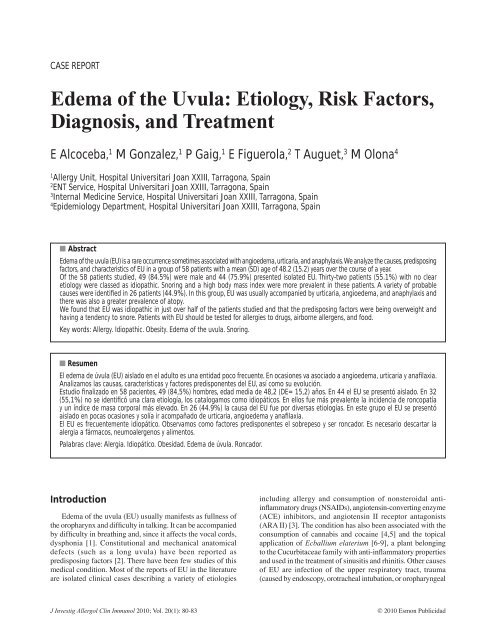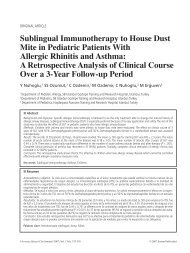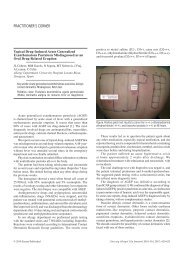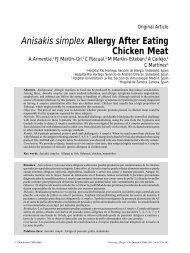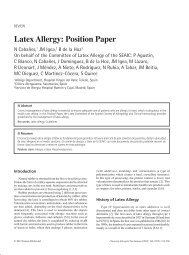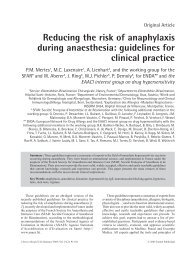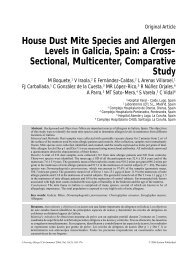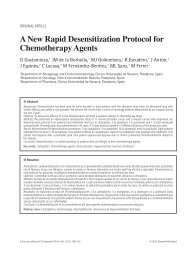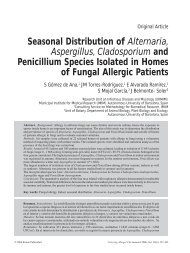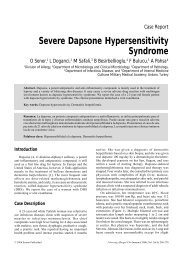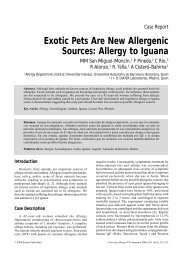Edema of the Uvula: Etiology, Risk Factors, Diagnosis, and Treatment
Edema of the Uvula: Etiology, Risk Factors, Diagnosis, and Treatment
Edema of the Uvula: Etiology, Risk Factors, Diagnosis, and Treatment
You also want an ePaper? Increase the reach of your titles
YUMPU automatically turns print PDFs into web optimized ePapers that Google loves.
E Alcoceba, et al<br />
CASE REPORT<br />
<strong>Edema</strong> <strong>of</strong> <strong>the</strong> <strong>Uvula</strong>: <strong>Etiology</strong>, <strong>Risk</strong> <strong>Factors</strong>,<br />
<strong>Diagnosis</strong>, <strong>and</strong> <strong>Treatment</strong><br />
E Alcoceba, 1 M Gonzalez, 1 P Gaig, 1 E Figuerola, 2 T Auguet, 3 M Olona 4<br />
1<br />
Allergy Unit, Hospital Universitari Joan XXIII, Tarragona, Spain<br />
2<br />
ENT Service, Hospital Universitari Joan XXIII, Tarragona, Spain<br />
3<br />
Internal Medicine Service, Hospital Universitari Joan XXIII, Tarragona, Spain<br />
4<br />
Epidemiology Department, Hospital Universitari Joan XXIII, Tarragona, Spain<br />
■ Abstract<br />
<strong>Edema</strong> <strong>of</strong> <strong>the</strong> uvula (EU) is a rare occurrence sometimes associated with angioedema, urticaria, <strong>and</strong> anaphylaxis. We analyze <strong>the</strong> causes, predisposing<br />
factors, <strong>and</strong> characteristics <strong>of</strong> EU in a group <strong>of</strong> 58 patients with a mean (SD) age <strong>of</strong> 48.2 (15.2) years over <strong>the</strong> course <strong>of</strong> a year.<br />
Of <strong>the</strong> 58 patients studied, 49 (84.5%) were male <strong>and</strong> 44 (75.9%) presented isolated EU. Thirty-two patients (55.1%) with no clear<br />
etiology were classed as idiopathic. Snoring <strong>and</strong> a high body mass index were more prevalent in <strong>the</strong>se patients. A variety <strong>of</strong> probable<br />
causes were identifi ed in 26 patients (44.9%). In this group, EU was usually accompanied by urticaria, angioedema, <strong>and</strong> anaphylaxis <strong>and</strong><br />
<strong>the</strong>re was also a greater prevalence <strong>of</strong> atopy.<br />
We found that EU was idiopathic in just over half <strong>of</strong> <strong>the</strong> patients studied <strong>and</strong> that <strong>the</strong> predisposing factors were being overweight <strong>and</strong><br />
having a tendency to snore. Patients with EU should be tested for allergies to drugs, airborne allergens, <strong>and</strong> food.<br />
Key words: Allergy. Idiopathic. Obesity. <strong>Edema</strong> <strong>of</strong> <strong>the</strong> uvula. Snoring.<br />
■ Resumen<br />
El edema de úvula (EU) aislado en el adulto es una entidad poco frecuente. En ocasiones va asociado a angioedema, urticaria y anafi laxia.<br />
Analizamos las causas, características y factores predisponentes del EU, así como su evolución.<br />
Estudio fi nalizado en 58 pacientes, 49 (84,5%) hombres, edad media de 48,2 (DE= 15,2) años. En 44 el EU se presentó aislado. En 32<br />
(55,1%) no se identifi có una clara etiología, los catalogamos como idiopáticos. En ellos fue más prevalente la incidencia de roncopatía<br />
y un índice de masa corporal más elevado. En 26 (44.9%) la causa del EU fue por diversas etiologías. En este grupo el EU se presentó<br />
aislado en pocas ocasiones y solía ir acompañado de urticaria, angioedema y anafi laxia.<br />
El EU es frecuentemente idiopático. Observamos como factores predisponentes el sobrepeso y ser roncador. Es necesario descartar la<br />
alergia a fármacos, neumoalergenos y alimentos.<br />
Palabras clave: Alergia. Idiopático. Obesidad. <strong>Edema</strong> de úvula. Roncador.<br />
Introduction<br />
<strong>Edema</strong> <strong>of</strong> <strong>the</strong> uvula (EU) usually manifests as fullness <strong>of</strong><br />
<strong>the</strong> oropharynx <strong>and</strong> difficulty in talking. It can be accompanied<br />
by difficulty in breathing <strong>and</strong>, since it affects <strong>the</strong> vocal cords,<br />
dysphonia [1]. Constitutional <strong>and</strong> mechanical anatomical<br />
defects (such as a long uvula) have been reported as<br />
predisposing factors [2]. There have been few studies <strong>of</strong> this<br />
medical condition. Most <strong>of</strong> <strong>the</strong> reports <strong>of</strong> EU in <strong>the</strong> literature<br />
are isolated clinical cases describing a variety <strong>of</strong> etiologies<br />
including allergy <strong>and</strong> consumption <strong>of</strong> nonsteroidal antiinflammatory<br />
drugs (NSAIDs), angiotensin-converting enzyme<br />
(ACE) inhibitors, <strong>and</strong> angiotensin II receptor antagonists<br />
(ARA II) [3]. The condition has also been associated with <strong>the</strong><br />
consumption <strong>of</strong> cannabis <strong>and</strong> cocaine [4,5] <strong>and</strong> <strong>the</strong> topical<br />
application <strong>of</strong> Ecballium elaterium [6-9], a plant belonging<br />
to <strong>the</strong> Cucurbitaceae family with anti-inflammatory properties<br />
<strong>and</strong> used in <strong>the</strong> treatment <strong>of</strong> sinusitis <strong>and</strong> rhinitis. O<strong>the</strong>r causes<br />
<strong>of</strong> EU are infection <strong>of</strong> <strong>the</strong> upper respiratory tract, trauma<br />
(caused by endoscopy, orotracheal intubation, or oropharyngeal<br />
J Investig Allergol Clin Immunol 2010; Vol. 20(1): 80-83<br />
© 2010 Esmon Publicidad
<strong>Edema</strong> <strong>of</strong> <strong>the</strong> <strong>Uvula</strong><br />
81<br />
aspiration), vascular alterations such as superior vein cava<br />
syndrome, ligature <strong>of</strong> <strong>the</strong> internal jugular vein, decrease in<br />
plasma osmotic pressure (occurring in renal insufficiency),<br />
obstruction <strong>of</strong> lymphatic flow after ligature <strong>of</strong> <strong>the</strong> thoracic duct,<br />
<strong>and</strong> increase in capillary permeability to proteins, occurring in<br />
diabetes or lupus. Differential diagnosis should be conducted<br />
for epiglottitis, myxedematous infiltration in hypothyroidism,<br />
<strong>and</strong> granulomatous infiltration in sarcoidosis <strong>and</strong> Merkelson-<br />
Rosenthal syndrome.<br />
The aim <strong>of</strong> <strong>the</strong> present study was to analyze <strong>the</strong> etiology,<br />
predisposing factors, <strong>and</strong> characteristics <strong>of</strong> EU in patients<br />
treated at our hospital <strong>and</strong> followed for a year.<br />
Case Description<br />
A prospective study was conducted between September<br />
2005 <strong>and</strong> April 2007 using a protocol jointly drawn up by<br />
<strong>the</strong> allergy unit <strong>and</strong> <strong>the</strong> ear, nose, <strong>and</strong> throat (ENT) service<br />
at Hospital Universitari Joan XXIII in Tarragona, Spain.<br />
The protocol was applied to patients with EU who visited<br />
<strong>the</strong> emergency department or were referred by <strong>the</strong>ir general<br />
practitioner to <strong>the</strong> allergy unit or ENT service. After an initial<br />
visit, patients were assessed approximately every 3 months<br />
for a year.<br />
The protocol involved confirmation <strong>of</strong> EU by direct visual<br />
observation <strong>of</strong> <strong>the</strong> oropharynx, followed by nas<strong>of</strong>ibroscopy.<br />
During history taking, special emphasis was placed on<br />
investigating personal <strong>and</strong> family histories <strong>of</strong> atopy <strong>and</strong><br />
angioedema. A record was also made <strong>of</strong> patients’ body mass<br />
index (BMI), regular medication, <strong>and</strong> illnesses occuring at <strong>the</strong><br />
same time as EU. When a probable association was found with<br />
a causal agent, <strong>the</strong> latency period <strong>and</strong> subsequent consumption,<br />
where relevant, were assessed. O<strong>the</strong>r data recorded were <strong>the</strong><br />
frequency <strong>of</strong> episodes <strong>and</strong> <strong>the</strong> time <strong>of</strong> occurrence.<br />
All patients underwent blood tests <strong>and</strong> biochemical analysis<br />
with measurement <strong>of</strong> erythrocyte sedimentation rate, hepatic<br />
enzymes, calcium <strong>and</strong> phosphorus levels, thyroid pr<strong>of</strong>ile,<br />
antinuclear antibodies, anti-DNA, antithyroid antibodies,<br />
protein pr<strong>of</strong>ile, complement levels (C3, C4, C1 inhibitor<br />
<strong>and</strong> C1q), as well as serum tryptase <strong>and</strong> total <strong>and</strong> specific<br />
immunoglobulin (Ig) E levels depending on skin test results.<br />
O<strong>the</strong>r examinations included skin prick tests to test for<br />
sensitization to common food <strong>and</strong> airborne allergens, stool<br />
tests for parasites, a chest X-ray to rule out pulmonary disease<br />
or tumors, a sinus X-ray, <strong>and</strong> spirometry with examination <strong>of</strong><br />
both <strong>the</strong> inspiratory curve to check for extrathoracic obstruction<br />
<strong>and</strong> <strong>the</strong> expiratory curve.<br />
Quantitative variables were described with means<br />
(SD) <strong>and</strong> categorical variables with absolute <strong>and</strong> relative<br />
frequencies. Groups were compared using <strong>the</strong> nonparametric<br />
Kruskal-Wallis test for continuous variables <strong>and</strong> <strong>the</strong> χ² test for<br />
categorical variables. Multiple logistic regression analysis was<br />
used to evaluate <strong>the</strong> association between snoring <strong>and</strong> idiopathic<br />
etiology adjusted for BMI <strong>and</strong> sex. Results were presented as<br />
odds ratios (OR) with <strong>the</strong>ir respective 95% confidence intervals<br />
(CIs). The level <strong>of</strong> statistical significance was set at P≤.05.<br />
Data were analysed using <strong>the</strong> SPSS 12.0 statistical program<br />
(SPSS Inc., Chicago, Illinois, USA).<br />
Our study comprised 58 patients, 49 (84.5%) <strong>of</strong> whom<br />
were men, with a mean (SD) age <strong>of</strong> 48.24 (15.2) years. EU<br />
was not concomitant with o<strong>the</strong>r complaints in 44 (75.9%) <strong>of</strong><br />
<strong>the</strong> cases.<br />
The patients were divided into 2 groups according to <strong>the</strong><br />
etiology <strong>of</strong> EU. Group 1 consisted <strong>of</strong> patients in whom no clear<br />
cause was detectable (n=32, 55.1%) <strong>and</strong> group 2 <strong>of</strong> patients in<br />
whom a probable cause was detected (n=26, 44.9%). Snoring<br />
was significantly more prevalent in group 1 than in group<br />
2 (P
82<br />
E Alcoceba, et al<br />
sulphate in 1 patient (2 separate episodes, hence no fur<strong>the</strong>r<br />
tests); <strong>and</strong> ipratropium bromide in 1 patient (negative skin<br />
test; inhalation challenge test not performed because <strong>the</strong><br />
patient was 85-years-old). Eight patients were found to<br />
have secondary causes, including consumption <strong>of</strong> cannabis<br />
(1 patient), ACE inhibitors (non-allergic) 2 patients), recent<br />
orotracheal intubation (1 patient), <strong>and</strong> pharyngotonsillar<br />
infection (4 patients). In comparison with <strong>the</strong> idiopathic group,<br />
EU in this group was more frequently accompanied by o<strong>the</strong>r<br />
clinical manifestations such as urticaria, angioedema, <strong>and</strong><br />
anaphylaxis in <strong>the</strong> case <strong>of</strong> food allergies (P
<strong>Edema</strong> <strong>of</strong> <strong>the</strong> <strong>Uvula</strong><br />
83<br />
de úvula tras consumo de cocaína por vía intranasal.<br />
Med Clín. 2002; 119: 438-9.<br />
6. Satar S, Gokel Y, Toprak N, Sebe A. Life-threatening uvular<br />
angioedema caused by Ecballium elaterium. Eur J Emerg Med.<br />
2001; 8: 337-9.<br />
7. Raikhlin-Eisenkraft B. Ecbalium elaterium remedy or poison.<br />
J Toxicol Clin Toxicol. 2000; 38: 305-8.<br />
8. Kloutsos G. Upper airway edema resulting from use <strong>of</strong> Ecballium<br />
elaterium. Laryngoscope. 2001; 111: 1652-5.<br />
9. Gianella A, Cabrera D, Mardónez J.M, Saldias F. Hierbas<br />
medicinales y graves efectos adversos: Angioedema de úvula<br />
causado por uso de Ecballium elaterium. Rev Méd Chile. 2002;<br />
130: 1407-10.<br />
10. Daschner A, Vega F. <strong>Uvula</strong>r angioedema: clinical <strong>and</strong> etiologic<br />
aspects in a series <strong>of</strong> 17 patients. XXII EAACI Congress. 2004<br />
June 12-16; Madrid Spain. Amsterdam: Springer; 2004. p. 57-8.<br />
11. Miller RJ, Gerhardt MA. <strong>Uvula</strong>r edema secondary to snoring<br />
under sleep sedation. Anesth Prog. 2006; 53:13-6.<br />
Manuscript received November 8, 2008; accepted for<br />
publication, May 5, 2009.<br />
Eva Alcoceba Borràs<br />
Unidad de Alergia<br />
Hospital Universitari de Tarragona Joan XXIII<br />
C/ Doctor Mallafré Guasch, 4<br />
43007 Tarragona, Spain<br />
E-mail: evaalcoceba@hotmail.com<br />
© 2010 Esmon Publicidad J Investig Allergol Clin Immunol 2010; Vol. 20(1): 80-83


